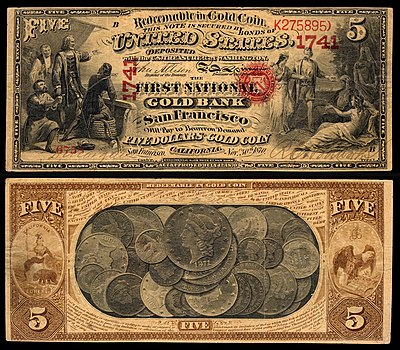Template:POTD/2020-07-17
Appearance
National Gold Bank Notes were issued by banks in California in the 1870s and 1880s, following the California Gold Rush. Gold coinage was the preferred means of exchange during this period but coinage was difficult for larger transactions, so these national bank notes were issued, redeemable in gold. Printed on yellow-tinted paper, the six denominations that circulated were $5, $10, $20, $50, $100, and $500. A $1,000 note was designed and printed, but never issued. Today, the higher-denomination notes are very rare, and only about 630 National Gold Bank Notes of all denominations are known still to be in existence.
This picture shows a five-dollar National Gold Bank Note issued by the First National Gold Bank of San Francisco. The note is hand-signed by Edwin D. Morgan and Ralph C. Woolworth, the bank's cashier and president, respectively.
Other denominations: Banknote design credit: Continental Bank Note Company; photographed by Andrew ShivaThis image was chosen at random from a selection of five. ()

